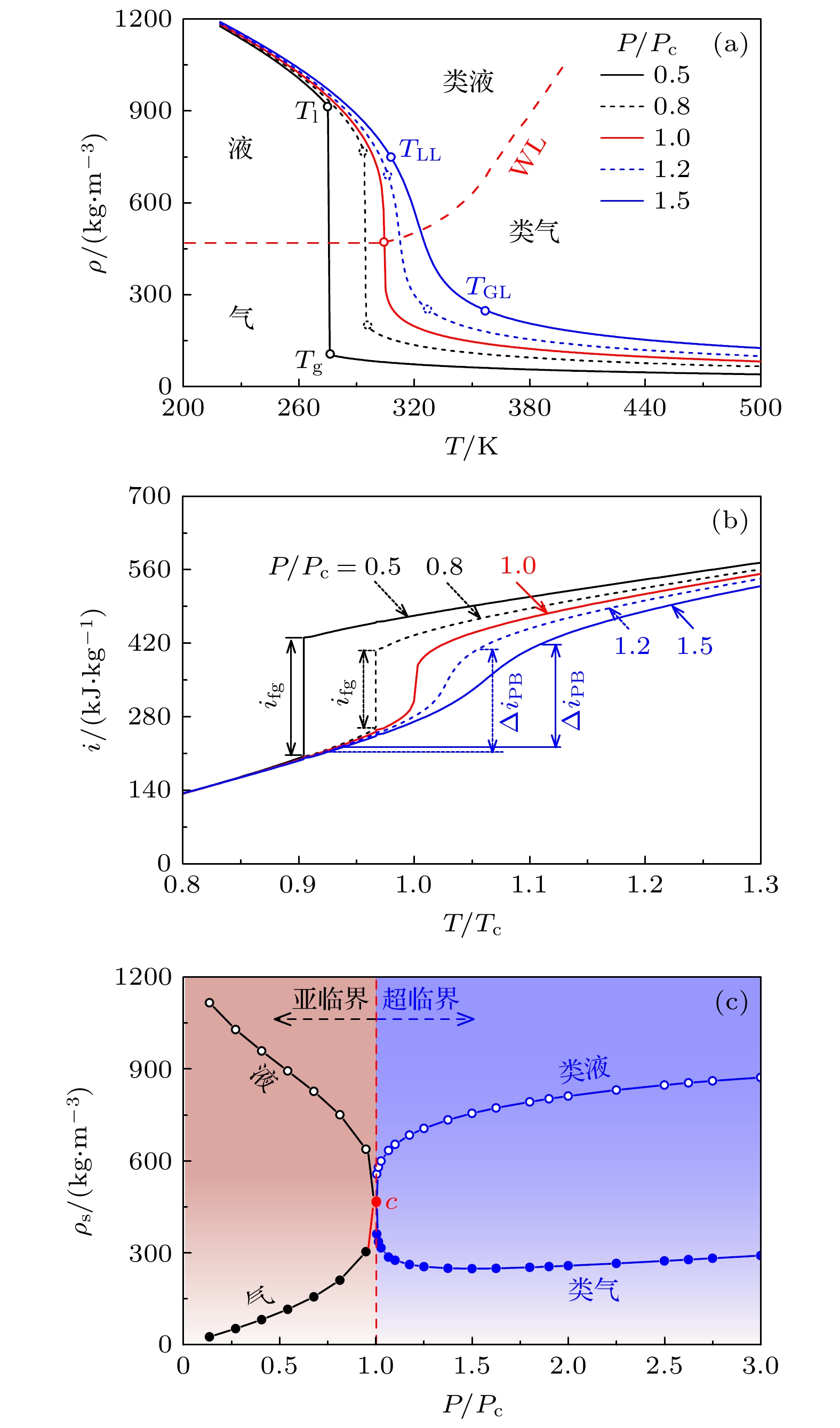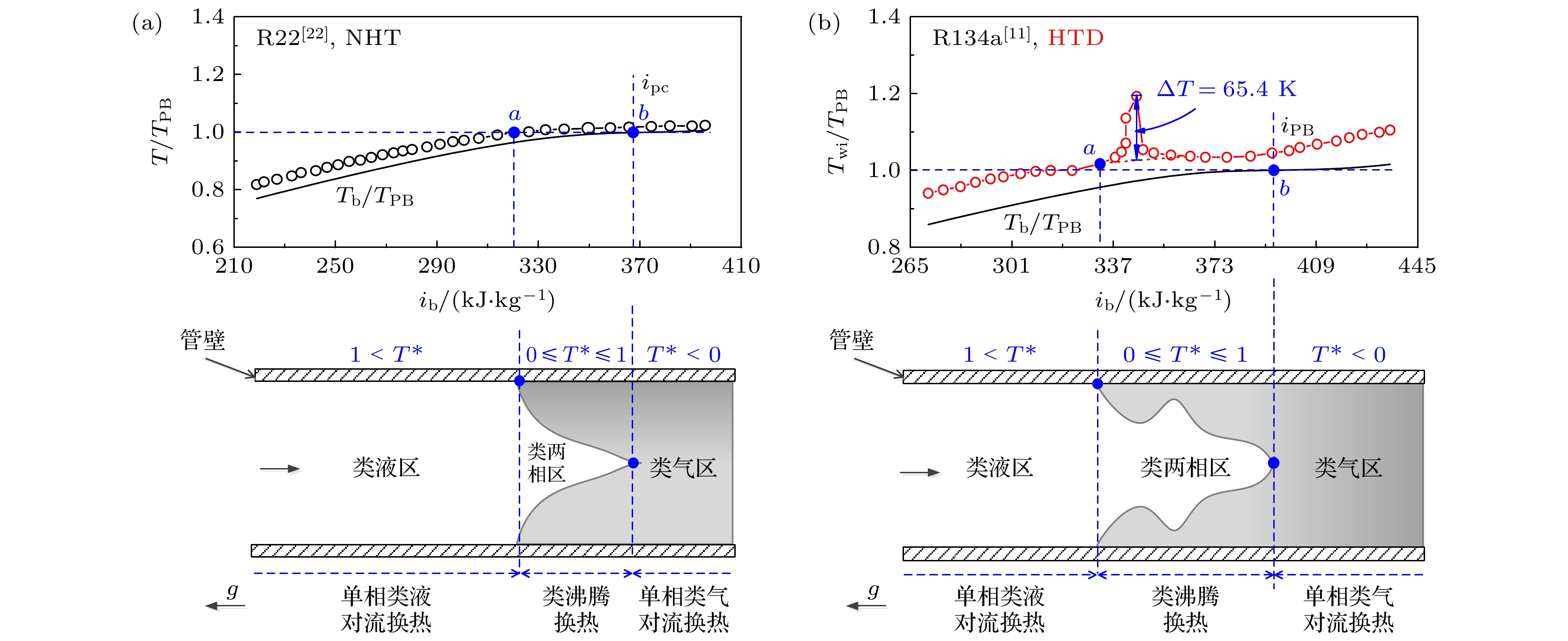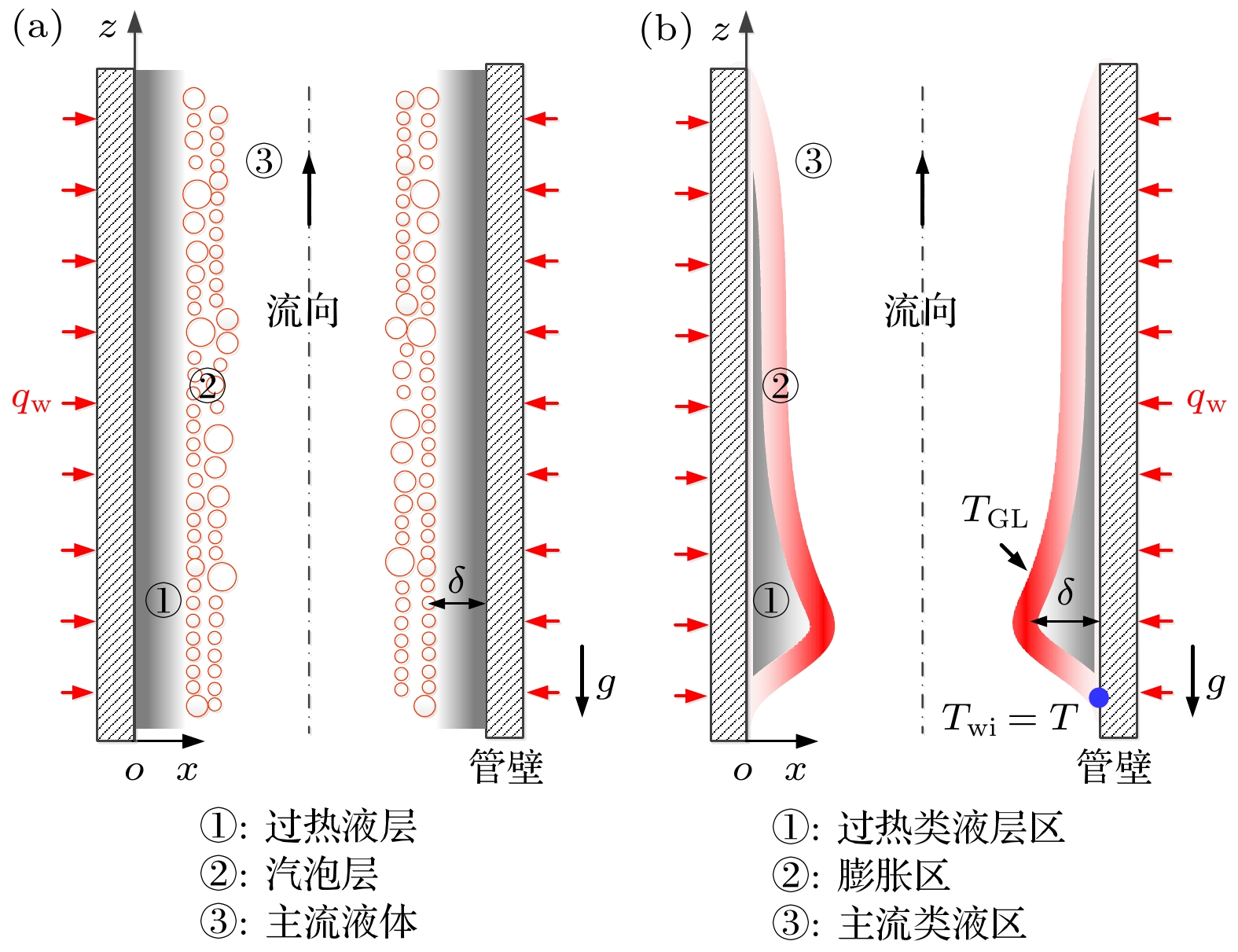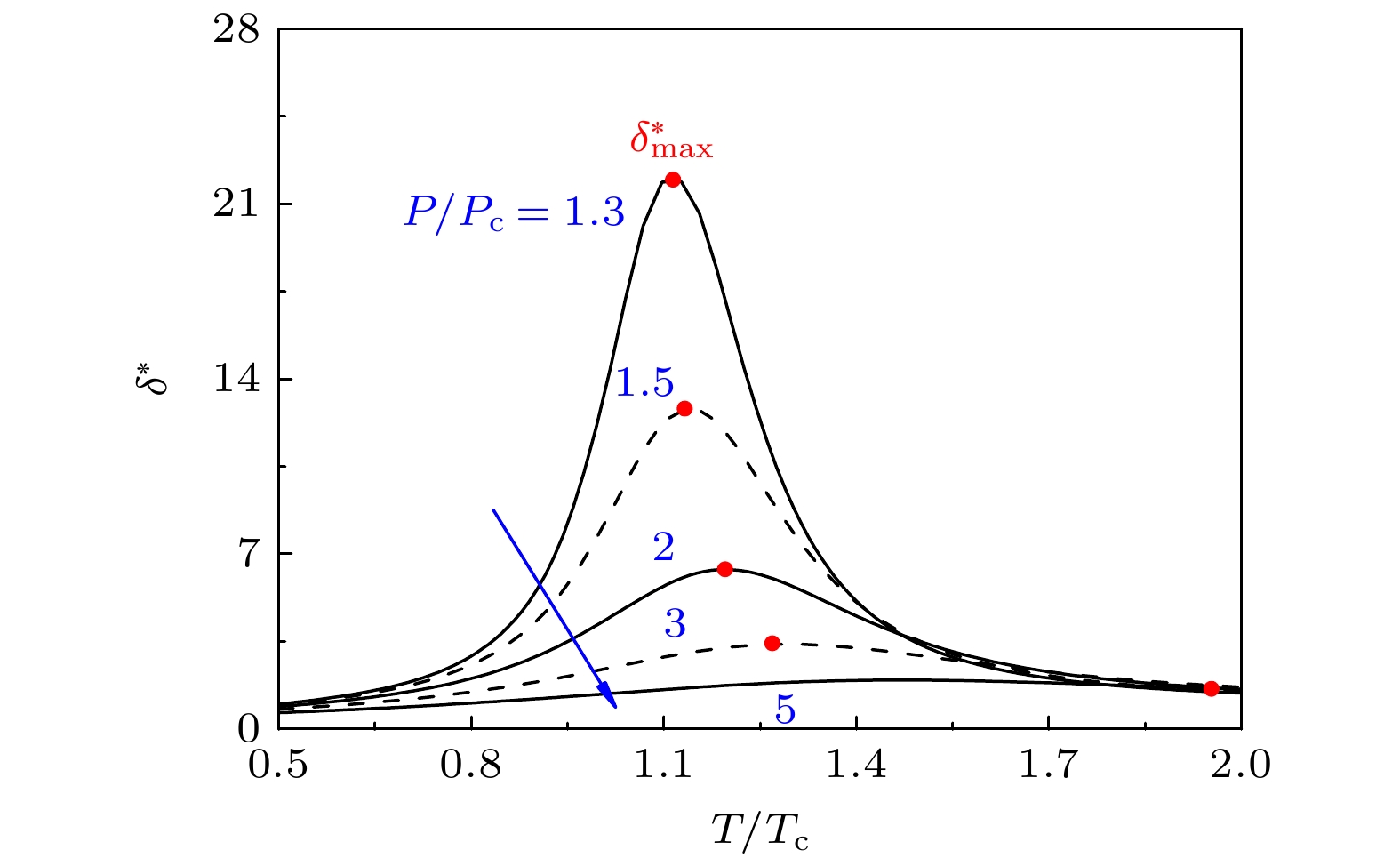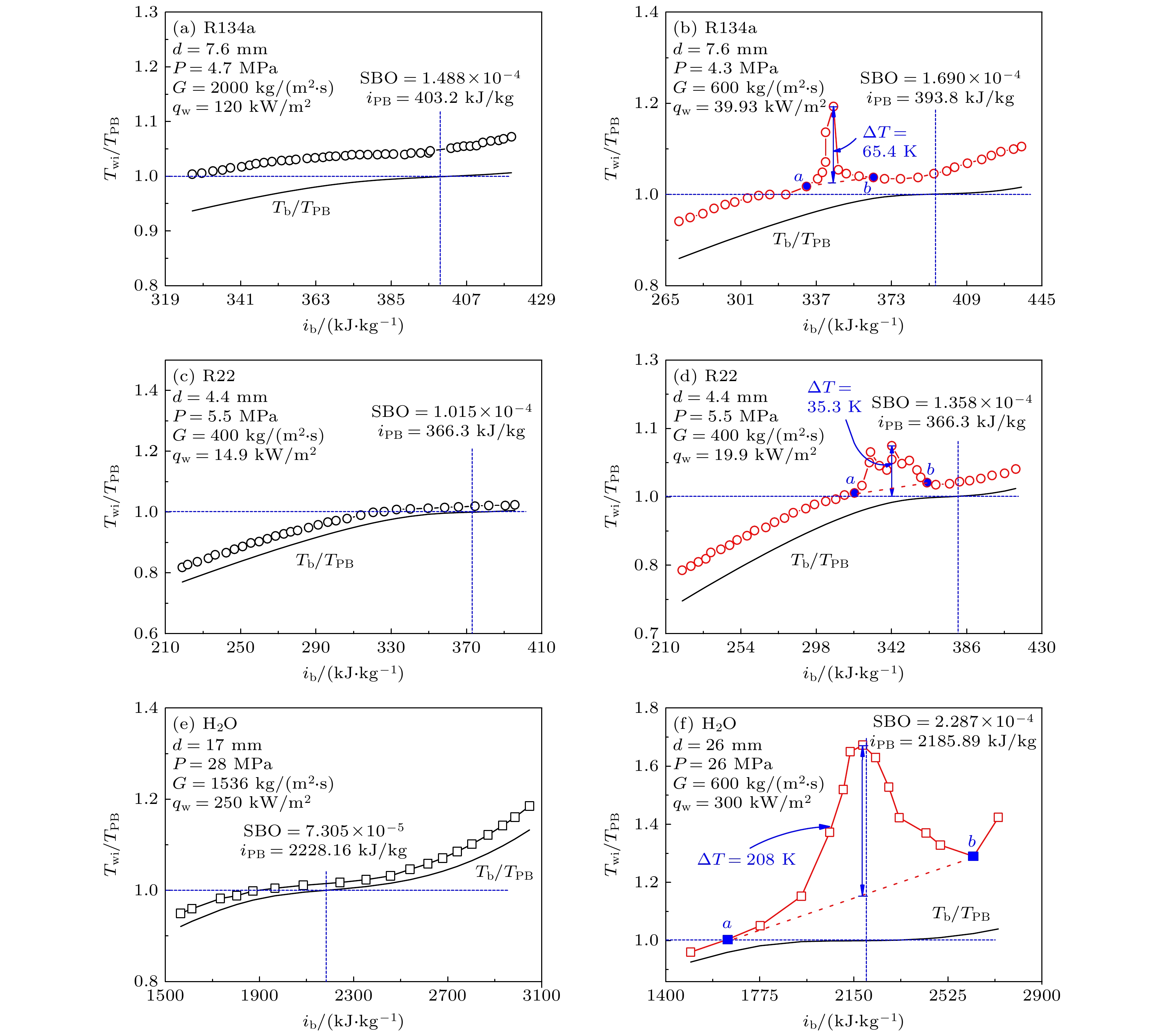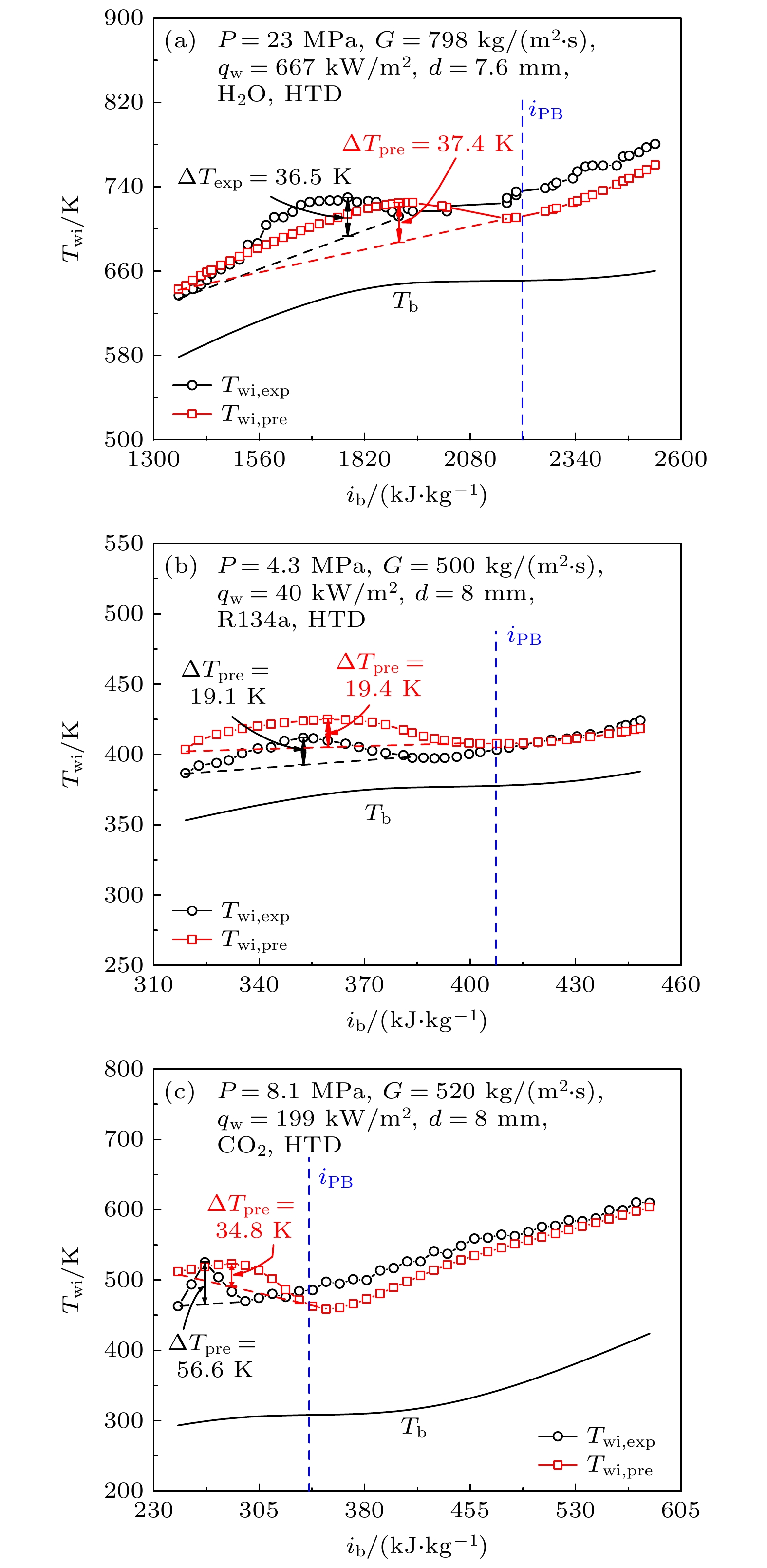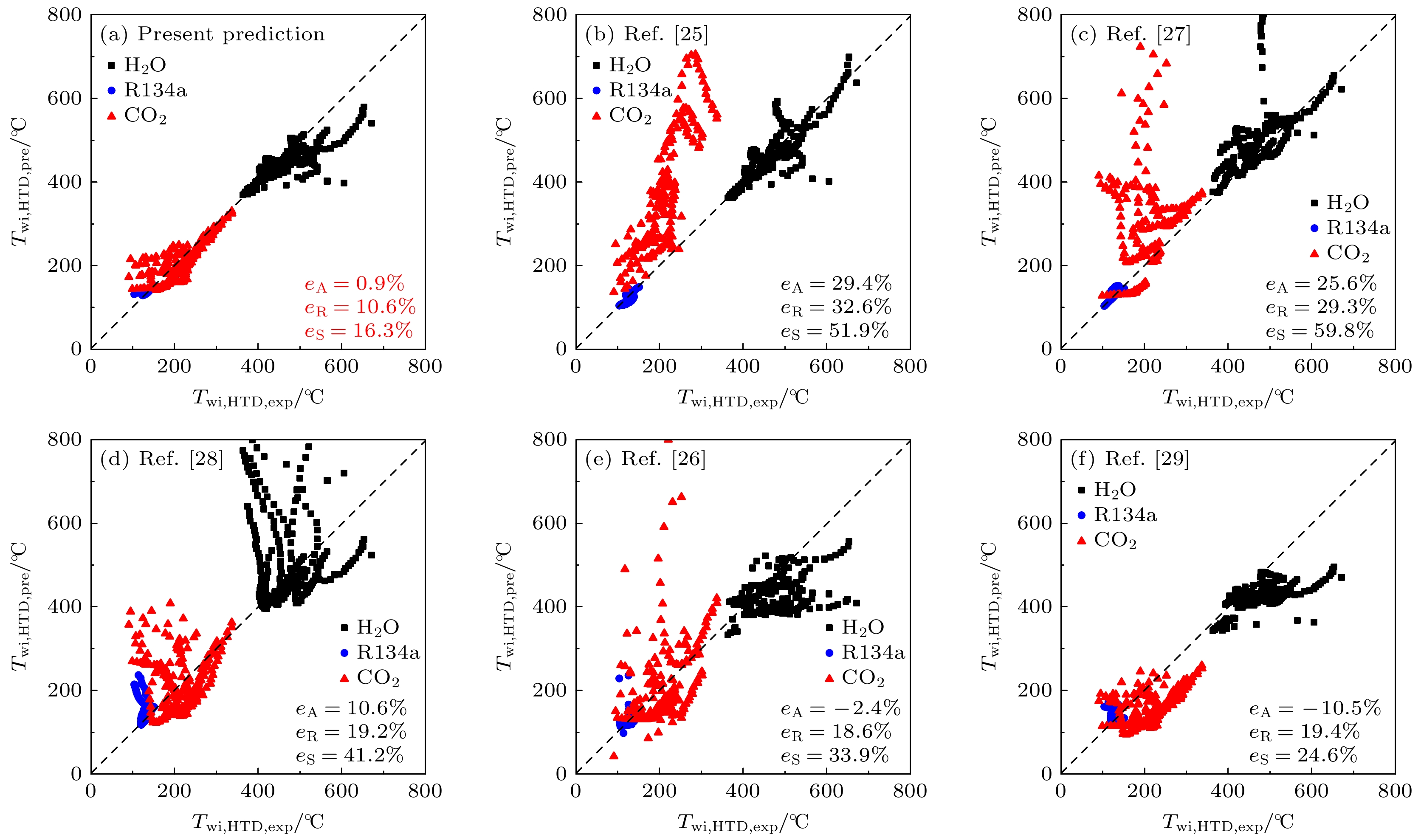-
Heat transfer deterioration (HTD) is one of the important issues in the study of supercritical fluid (SCF) heat transfer. However, when the SCF crosses the pseudo-critical point, the none-quilibrium process occurs in liquid, so SCF is very complicated. Recently, the existence of SCF pseudo-boiling on a macro scale has sparked controversy. There is still no unified understanding of the mechanism of gas-like and liquid-like transition affecting heat transfer. In this work, it is assumed that SCF has a macroscopic phenomenon similar to subcritical flow boiling. By analogy with subcritical boiling heat transfer, a boiling critical point model is proposed to describe the HTD in supercritical CO2. Our study reveals that the HTD caused by pseudo-boiling only occurs under large temperature gradient, which makes the superheated liquid-like layer cover the wall, and the gas-like and liquid-like may present different distribution forms, thus changing the heat transfer characteristics. When the wall temperature is higher than the pseudo-critical temperature and the enthalpy of the fluid layer covering the wall exceeds a certain value, the HTD may occur. The proposed theoretical model can explain the experimental results well, and the prediction accuracy of heat transfer correlation considering pseudo-boiling is greatly improved. In this work, the connection between supercritical heat transfer and subcritical heat transfer is established theoretically, which provides a new idea for studying the deterioration of SCF heat transfer, thus enriching the theory of supercritical heat transfer.
-
Keywords:
- supercritical fluid /
- expansion /
- pseudo-boiling /
- heat transfer deterioration /
- theoretical model
[1] Jackson J D 2017 Appl. Therm. Eng. 124 1481
 Google Scholar
Google Scholar
[2] Huang D, Wu Z, Sunden B, Li W 2016 Appl. Energ. 162 494
 Google Scholar
Google Scholar
[3] Xie J Z, Liu D C, Yan H B, Xie G N, Boetcher S K S 2020 Int. J. Heat Mass Tran. 149 119233
 Google Scholar
Google Scholar
[4] Cabeza L, Gracia A, Fernández A, Farid M 2017 Appl. Therm. Eng. 125 799
 Google Scholar
Google Scholar
[5] Chen W W, Fang X D, Yu X, Su X H 2015 Ann. Nucl. Energy 76 451
 Google Scholar
Google Scholar
[6] Cheng X, Liu X J 2018 J. Nucl. Eng. Radiat Sc. 4 011003
 Google Scholar
Google Scholar
[7] Maxim F, Contescu C, Boillat P, Niceno B, Karalis K, Testino A, Ludwig C 2019 Nat. Commun. 10 4114
 Google Scholar
Google Scholar
[8] Maxim F, Karalis K, Boillat P, Banuti D, Marquez J, Damian B, Niceno P, Ludwig C 2021 Adv. Sci. 8 2002312
 Google Scholar
Google Scholar
[9] Liu M Y, Tang J, Liu S H 2022 J. Supercrit. Fluids 183 105554
 Google Scholar
Google Scholar
[10] Ackerman J W 1970 J. Heat Tran. 92 490
 Google Scholar
Google Scholar
[11] Zhu B G, Xu J L, Wu X M, Xie J, Li M J 2019 J Int. J. Therm. Sci. 136 254
 Google Scholar
Google Scholar
[12] Zhang H S, Xu J L, Zhu X J, Xie J, Li M J, Zhu B G 2021 Appl. Therm. Eng. 182 116078
 Google Scholar
Google Scholar
[13] Wang Q Y, Ma X J, Xu J L, Li M J, Wang Y 2021 Int. J. Heat Mass Tran. 181 121875
 Google Scholar
Google Scholar
[14] Tripathi P, Basu S 2021 Phys. Fluids 33 043304
 Google Scholar
Google Scholar
[15] Wang J T, Li Z H, Zhai Y L, Wang H 2023 Int. J. Heat Mass Tran. 201 123571
 Google Scholar
Google Scholar
[16] Peeters J 2022 Int. J. Heat Mass Tran. 186 122441
 Google Scholar
Google Scholar
[17] Fan Y H, Tang G H, Sheng Q, Li X 2023 Energy 262 125470
 Google Scholar
Google Scholar
[18] Banuti D T 2015 J. Supercrit. Fluids 98 12
 Google Scholar
Google Scholar
[19] 何孝天, 徐进良, 程怡玮 2023 物理学报 72 057801
 Google Scholar
Google Scholar
He X T, Xu J L, Cheng Y W 2023 Acta Phys. Sin. 72 057801
 Google Scholar
Google Scholar
[20] 林瑞泰 1988 沸腾换热 (北京: 科学出版社) 第278页
Lin R T 1988 Boiling Heat Transfer (Beijing: Science Press) p278
[21] Xu J L, Zhang H S, Zhu B G, Xie J 2020 Solar Eng. 195 27
 Google Scholar
Google Scholar
[22] 张海松, 徐进良, 朱鑫杰 2021 物理学报 70 044401
 Google Scholar
Google Scholar
Zhang H S, Xu J L, Zhu X J 2021 Acta Phys. Sin. 70 044401
 Google Scholar
Google Scholar
[23] Zhang H S, Xu J L, Wang Q Y 2023 Int. J. Therm. Sci. 188 108242
 Google Scholar
Google Scholar
[24] Zhu B G, Xu J L, Yan C S, Xie J 2020 Int. J. Heat Mass Tran. 148 119080
 Google Scholar
Google Scholar
[25] Cheng X, Zhao M, Feuerstein F, Liu X J 2019 Int. J. Heat Mass Tran. 131 527
 Google Scholar
Google Scholar
[26] Gupta S, Mokry S, Pioro I 2011 Proc. ICONE-19 43503 11
 Google Scholar
Google Scholar
[27] Mokry S, Pioro I, Farah A, King K, Gupta S, Peiman W, Kirillov P 2011 Nucl. Eng. Des. 241 1126
 Google Scholar
Google Scholar
[28] Kim D, Kim M 2010 Nucl. Eng. Des. 240 3336
 Google Scholar
Google Scholar
[29] Petukhov B, Kirillov S 1958 Thermal Eng. 4 63
-
表 1 超临界流体传热关联式回顾
Table 1. Review of supercutical fluids heat transfer correlations.
Ref. Correlation Operatings parameters [25] $N{u_{\text{b}}} = 0.023 Re_{\text{b}}^{1.03}Pr_{\text{b}}^{0.5}{F_1}{F_2} \qquad\qquad \qquad \qquad \qquad \qquad \qquad \qquad $ CO2/H2O/R134a ${F_1} = \left\{ {\begin{aligned} &0.98, & &{\text{ for }}{{\textit{π}} _{\text{A}}} < 1.75 \times {{10}^{ - 4}}, \\ &0.85 + 0.056{{\left( {{{10}^4}{{\textit{π}} _{\text{A}}}} \right)}^{1.5}}, & &{\text{ for }}1.75 \times {{10}^{ - 4}} \leqslant {{\textit{π}} _{\text{A}}} < 3.75 \times {{10}^{ - 4}}, \\ &13.1/4.5 + {{\left( {104{{\textit{π}} _{\text{A}}}} \right)}^{1.35}}, & &{\text{ for }}3.75 \times {{10}^{ - 4}} < {{\textit{π}} _{\text{A}}} ,\end{aligned}} \right.$ $ {F_2} = \left\{ {\begin{aligned} & 0.93 Pr_{\text{b}}^{0.265}, & &{\text{ for }}P{r_{\text{b}}} \leqslant 2.5, \\ &1.61 Pr_{\text{b}}^{ - 0.333}, & &{\text{ for }}P{r_{\text{b}}} > 2.5, \end{aligned}} \right. \qquad {{\textit{π}} _{\text{A}}} = \dfrac{{{q_{\text{w}}}{\beta _{\text{b}}}}}{{G{c_{{\text{p}}, {\text{b}}}}}} \qquad\qquad \qquad\qquad $ [26] $N u_{\mathrm{w}}=0.0033 R e_{\mathrm{w}}^{0.94} \overline{Pr}_{\mathrm{w}}^{0.76}\left( {\rho_{\mathrm{w}}}/{\rho_{\mathrm{b}}}\right)^{0.16}\left( {\mu_{\mathrm{w}}}/{\mu_{\mathrm{b}}}\right)^{0.4} $ — [27] $N u_{\mathrm{b}}=0.0061 R e_{\mathrm{b}}^{0.904} P r_{\mathrm{b}, \mathrm{ave}}^{0.684}\left({\rho_{\mathrm{w}}}/{\rho_{\mathrm{b}}}\right)^{0.564}$ H2O
P = 24 MPa; di = 10.0 mm
G = 200—1500 kg/(m2·s)
qw = 0—1250 kW/m2$P{r_{{\mathrm{b, ave}}}} = \dfrac{{{\mu _{\text{b}}}}}{{{\lambda _{{\mathrm{b}}} }}}\dfrac{{{i_{{\mathrm{w}}} } - {i_{{\mathrm{b}}} }}}{{{T_{{\mathrm{w}}} } - {T_{{\mathrm{b}}} }}}$ [28] $ N{u_{\mathrm{b}}} = 0.226 Re_{\mathrm{b}}^{1.174}Pr_{{{\mathrm{b}}} , {\mathrm{ave}}}^{1.057}{\left( {\dfrac{{{\rho _{\mathrm{w}}}}}{{{\rho _{{\mathrm{b}}} }}}} \right)^{0.571}}{\left( {\dfrac{{{{\overline c }_{{{\mathrm{p, b}}}}}}}{{{c_{{{\mathrm{p} , b}}}}}}} \right)^{1.023}}A{c^{0.489}}B{u^{0.0021}} $ CO2
P = 7.46—10.26 MPa
di = 4.5 mm
G = 208–847 kg/(m2·s)
qw = 38—234 kW/m2$Ac = \dfrac{{{q_{{\mathrm{w}}} }{\beta _{{\mathrm{b}}} }}}{{G{c_{{{\mathrm{p}}} , {\mathrm{b}}}}Re_{{\mathrm{b}}} ^{0.625}}}\left( {\dfrac{{{\mu _{{\mathrm{w}}} }}}{{{\mu _{{\mathrm{b}}} }}}} \right){\left( {\dfrac{{{\rho _{{\mathrm{b}}} }}}{{{\rho _{{\mathrm{w}}} }}}} \right)^{0.5}}$, $Gr{=}\dfrac{{{g} {\beta _{{\mathrm{b}}} }d_{\mathrm{i}}^4{q_{{\mathrm{w}}} }}}{{v_{\mathrm{b}}^2{\lambda _{{\mathrm{b}}} }}}$ $ Bu = \dfrac{{Gr}}{{Re_{{\mathrm{b}}} ^{3.425}P{r^{0.8}}}}\left( {\dfrac{{{\mu _{{\mathrm{w}}} }}}{{{\mu _{{\mathrm{b}}} }}}} \right){\left( {\dfrac{{{\rho _{{\mathrm{b}}} }}}{{{\rho _{{\mathrm{w}}} }}}} \right)^{0.5}}$, ${\overline c _{{{\mathrm{p, b}}}}} = \dfrac{{{i_{{\mathrm{w}}} } - {i_{{\mathrm{b}}} }}}{{{T_{{\mathrm{w}}} } - {T_{{\mathrm{b}}} }}}$ [29] $ N u_{\mathrm{b}}=\dfrac{(\xi / 8) R e_{\mathrm{b}} \overline{{Pr}}_{\mathrm{b}}}{1+900 / R e_{\mathrm{b}}+12.7 \sqrt{\xi / 8}\left(\overline{P r}_{\mathrm{b}}^{2 / 3}-1\right)}$ — $\xi=\left[1.82 \log _{10}\left(R e_{\mathrm{b}}\right)-1.64\right]^{-2}\left( {\rho_{\mathrm{w}}}/{\rho_{\mathrm{b}}}\right)^{0.4}\left({\mu_{\mathrm{w}}}/{\mu_{\mathrm{b}}}\right)^{0.2}$ -
[1] Jackson J D 2017 Appl. Therm. Eng. 124 1481
 Google Scholar
Google Scholar
[2] Huang D, Wu Z, Sunden B, Li W 2016 Appl. Energ. 162 494
 Google Scholar
Google Scholar
[3] Xie J Z, Liu D C, Yan H B, Xie G N, Boetcher S K S 2020 Int. J. Heat Mass Tran. 149 119233
 Google Scholar
Google Scholar
[4] Cabeza L, Gracia A, Fernández A, Farid M 2017 Appl. Therm. Eng. 125 799
 Google Scholar
Google Scholar
[5] Chen W W, Fang X D, Yu X, Su X H 2015 Ann. Nucl. Energy 76 451
 Google Scholar
Google Scholar
[6] Cheng X, Liu X J 2018 J. Nucl. Eng. Radiat Sc. 4 011003
 Google Scholar
Google Scholar
[7] Maxim F, Contescu C, Boillat P, Niceno B, Karalis K, Testino A, Ludwig C 2019 Nat. Commun. 10 4114
 Google Scholar
Google Scholar
[8] Maxim F, Karalis K, Boillat P, Banuti D, Marquez J, Damian B, Niceno P, Ludwig C 2021 Adv. Sci. 8 2002312
 Google Scholar
Google Scholar
[9] Liu M Y, Tang J, Liu S H 2022 J. Supercrit. Fluids 183 105554
 Google Scholar
Google Scholar
[10] Ackerman J W 1970 J. Heat Tran. 92 490
 Google Scholar
Google Scholar
[11] Zhu B G, Xu J L, Wu X M, Xie J, Li M J 2019 J Int. J. Therm. Sci. 136 254
 Google Scholar
Google Scholar
[12] Zhang H S, Xu J L, Zhu X J, Xie J, Li M J, Zhu B G 2021 Appl. Therm. Eng. 182 116078
 Google Scholar
Google Scholar
[13] Wang Q Y, Ma X J, Xu J L, Li M J, Wang Y 2021 Int. J. Heat Mass Tran. 181 121875
 Google Scholar
Google Scholar
[14] Tripathi P, Basu S 2021 Phys. Fluids 33 043304
 Google Scholar
Google Scholar
[15] Wang J T, Li Z H, Zhai Y L, Wang H 2023 Int. J. Heat Mass Tran. 201 123571
 Google Scholar
Google Scholar
[16] Peeters J 2022 Int. J. Heat Mass Tran. 186 122441
 Google Scholar
Google Scholar
[17] Fan Y H, Tang G H, Sheng Q, Li X 2023 Energy 262 125470
 Google Scholar
Google Scholar
[18] Banuti D T 2015 J. Supercrit. Fluids 98 12
 Google Scholar
Google Scholar
[19] 何孝天, 徐进良, 程怡玮 2023 物理学报 72 057801
 Google Scholar
Google Scholar
He X T, Xu J L, Cheng Y W 2023 Acta Phys. Sin. 72 057801
 Google Scholar
Google Scholar
[20] 林瑞泰 1988 沸腾换热 (北京: 科学出版社) 第278页
Lin R T 1988 Boiling Heat Transfer (Beijing: Science Press) p278
[21] Xu J L, Zhang H S, Zhu B G, Xie J 2020 Solar Eng. 195 27
 Google Scholar
Google Scholar
[22] 张海松, 徐进良, 朱鑫杰 2021 物理学报 70 044401
 Google Scholar
Google Scholar
Zhang H S, Xu J L, Zhu X J 2021 Acta Phys. Sin. 70 044401
 Google Scholar
Google Scholar
[23] Zhang H S, Xu J L, Wang Q Y 2023 Int. J. Therm. Sci. 188 108242
 Google Scholar
Google Scholar
[24] Zhu B G, Xu J L, Yan C S, Xie J 2020 Int. J. Heat Mass Tran. 148 119080
 Google Scholar
Google Scholar
[25] Cheng X, Zhao M, Feuerstein F, Liu X J 2019 Int. J. Heat Mass Tran. 131 527
 Google Scholar
Google Scholar
[26] Gupta S, Mokry S, Pioro I 2011 Proc. ICONE-19 43503 11
 Google Scholar
Google Scholar
[27] Mokry S, Pioro I, Farah A, King K, Gupta S, Peiman W, Kirillov P 2011 Nucl. Eng. Des. 241 1126
 Google Scholar
Google Scholar
[28] Kim D, Kim M 2010 Nucl. Eng. Des. 240 3336
 Google Scholar
Google Scholar
[29] Petukhov B, Kirillov S 1958 Thermal Eng. 4 63
Catalog
Metrics
- Abstract views: 4416
- PDF Downloads: 66
- Cited By: 0














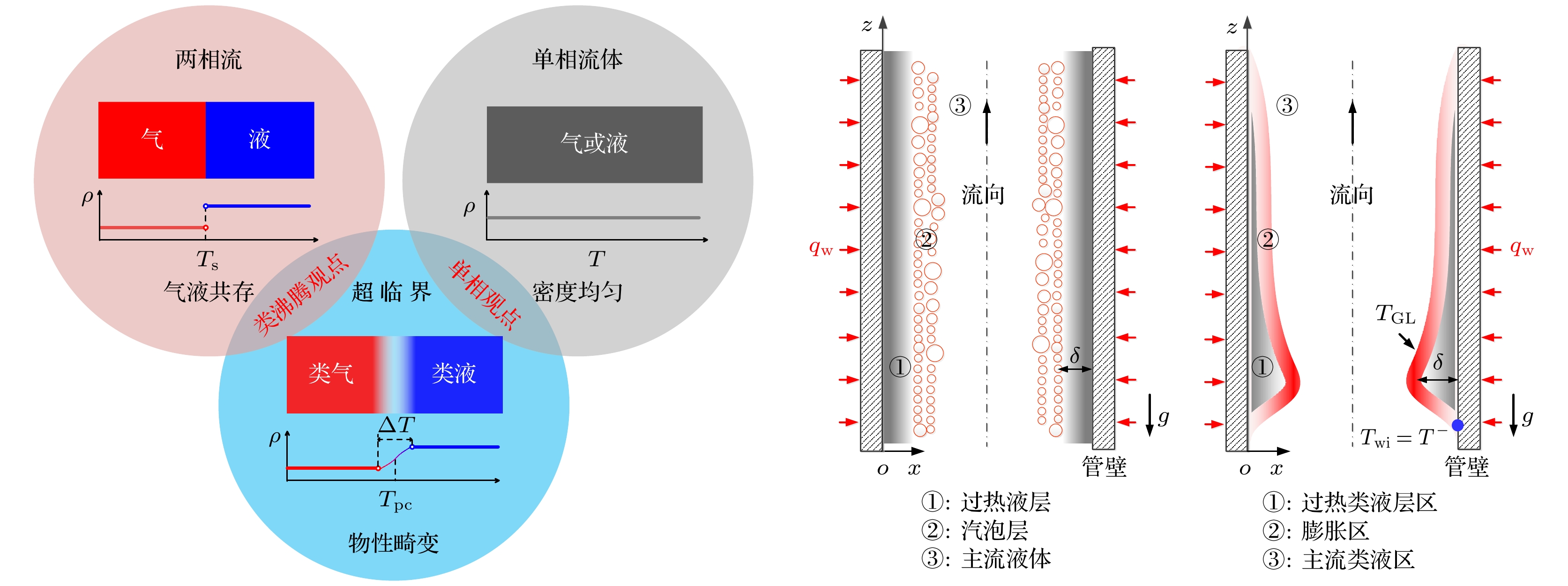
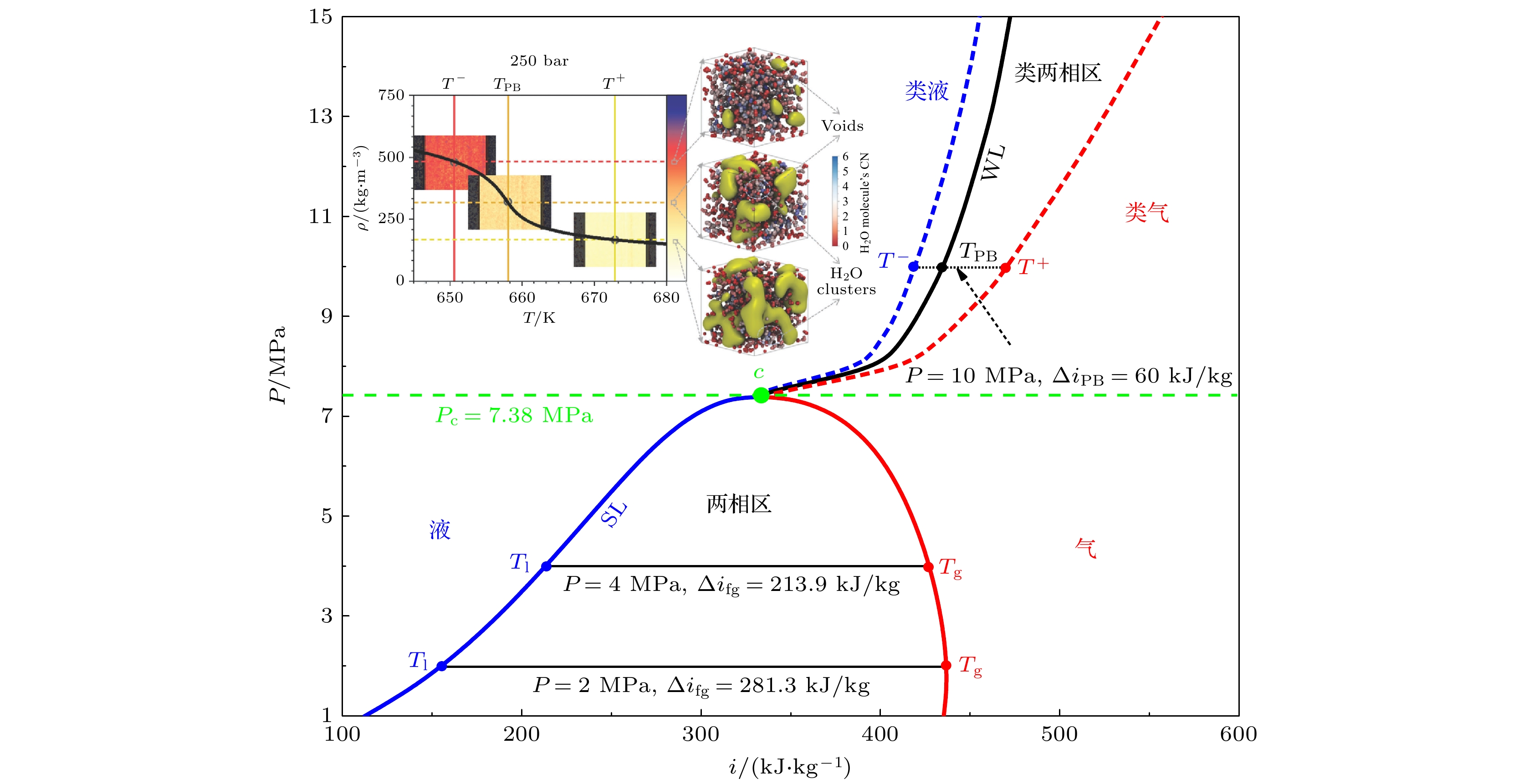
 DownLoad:
DownLoad:
